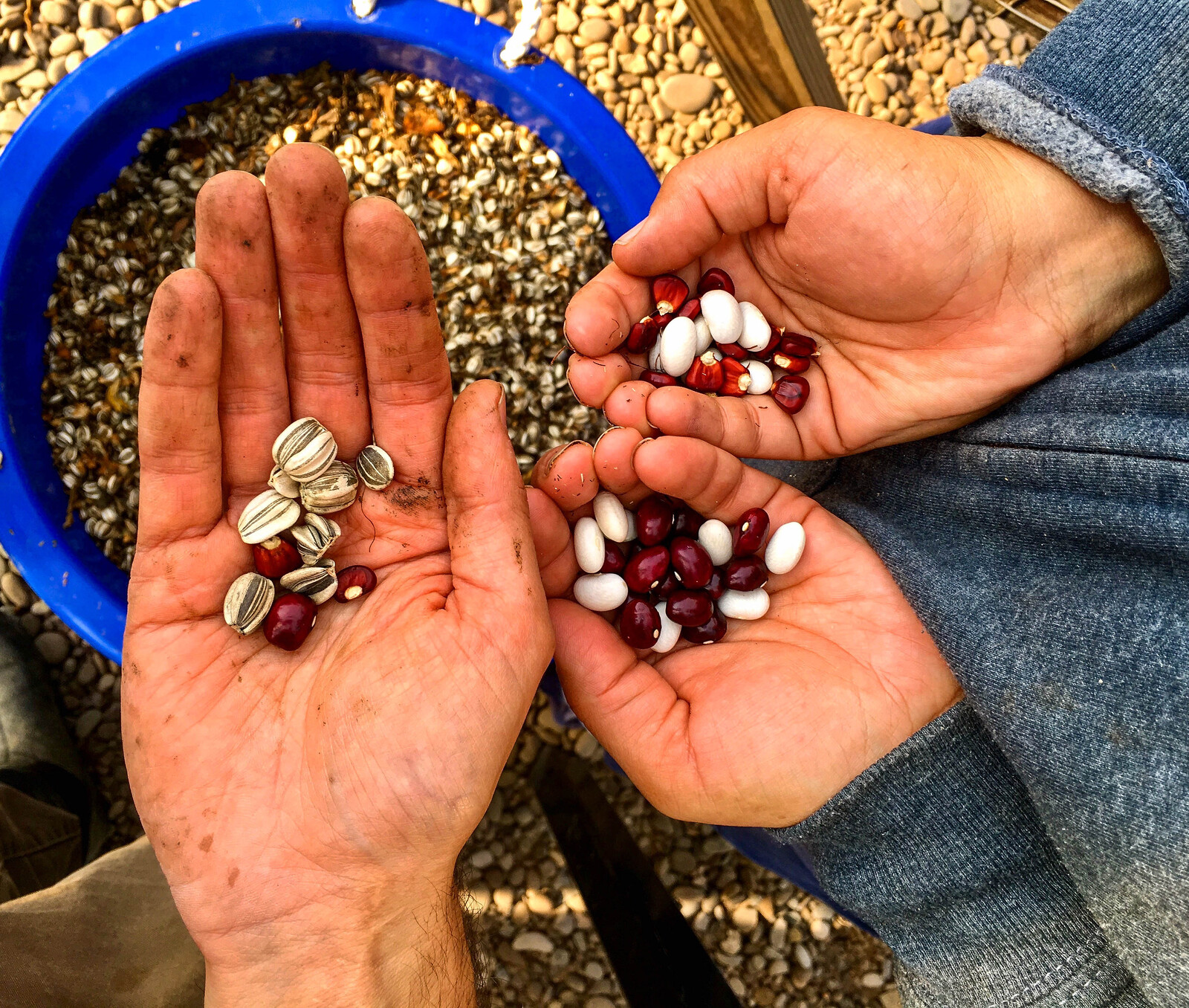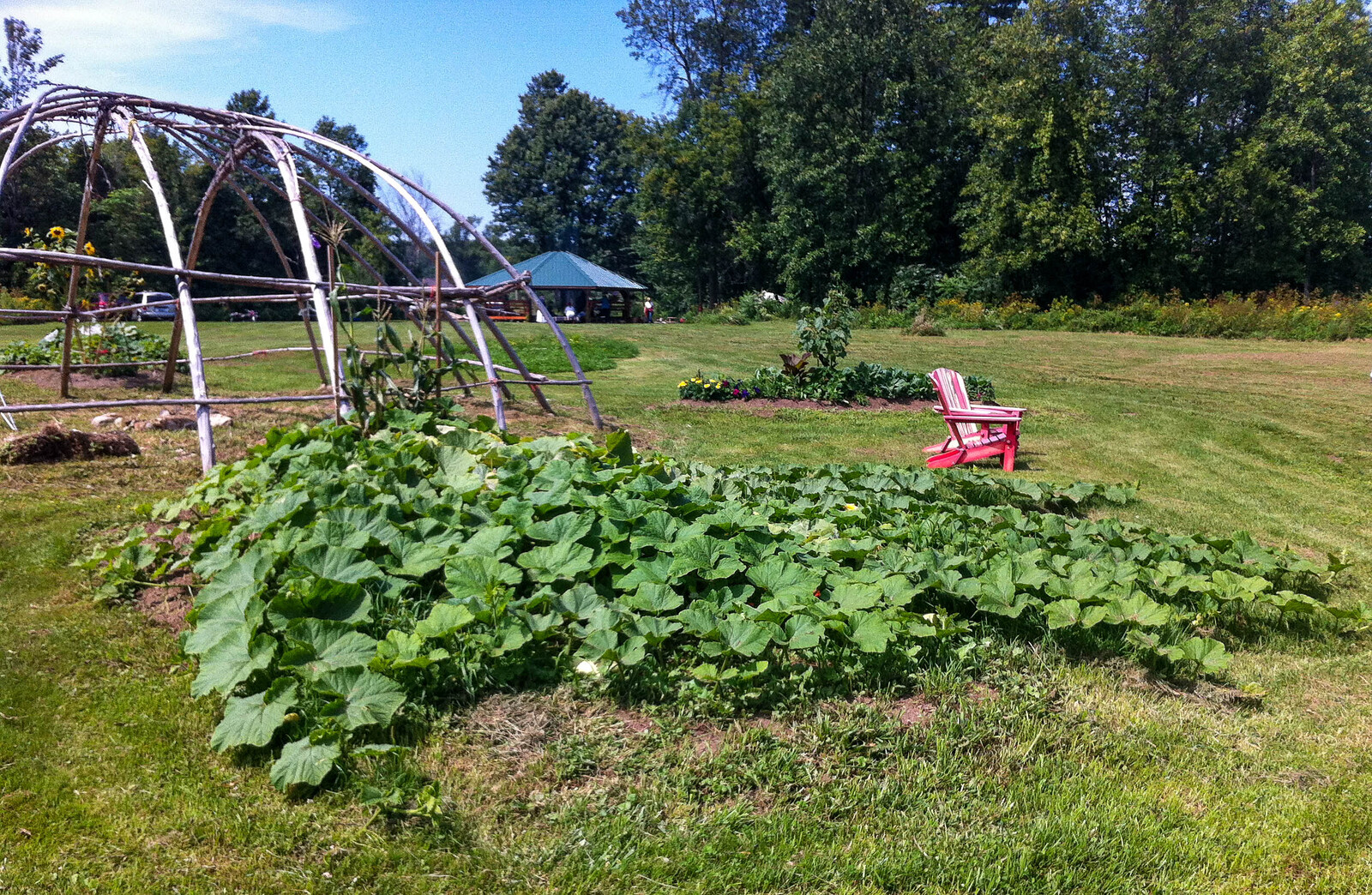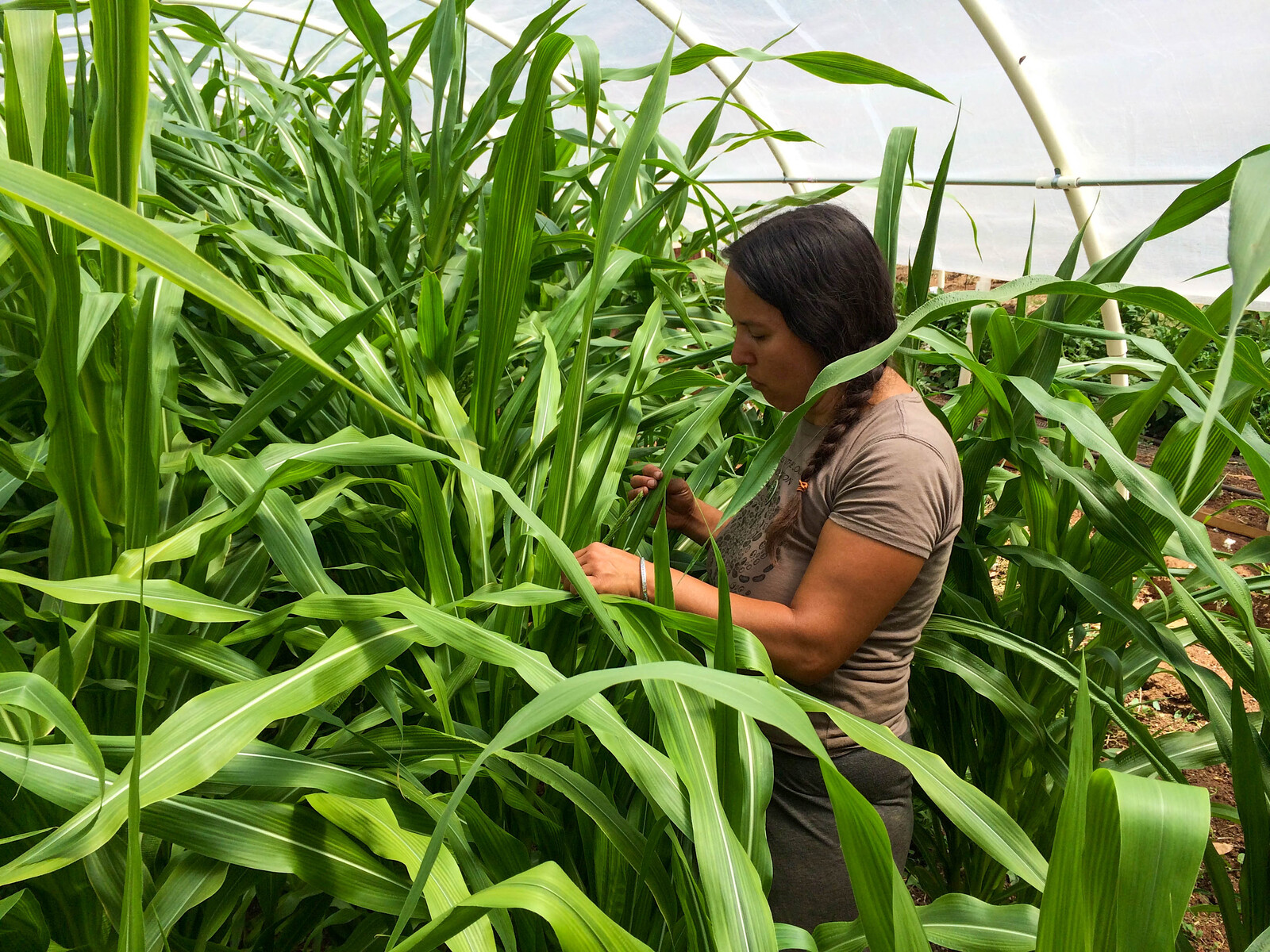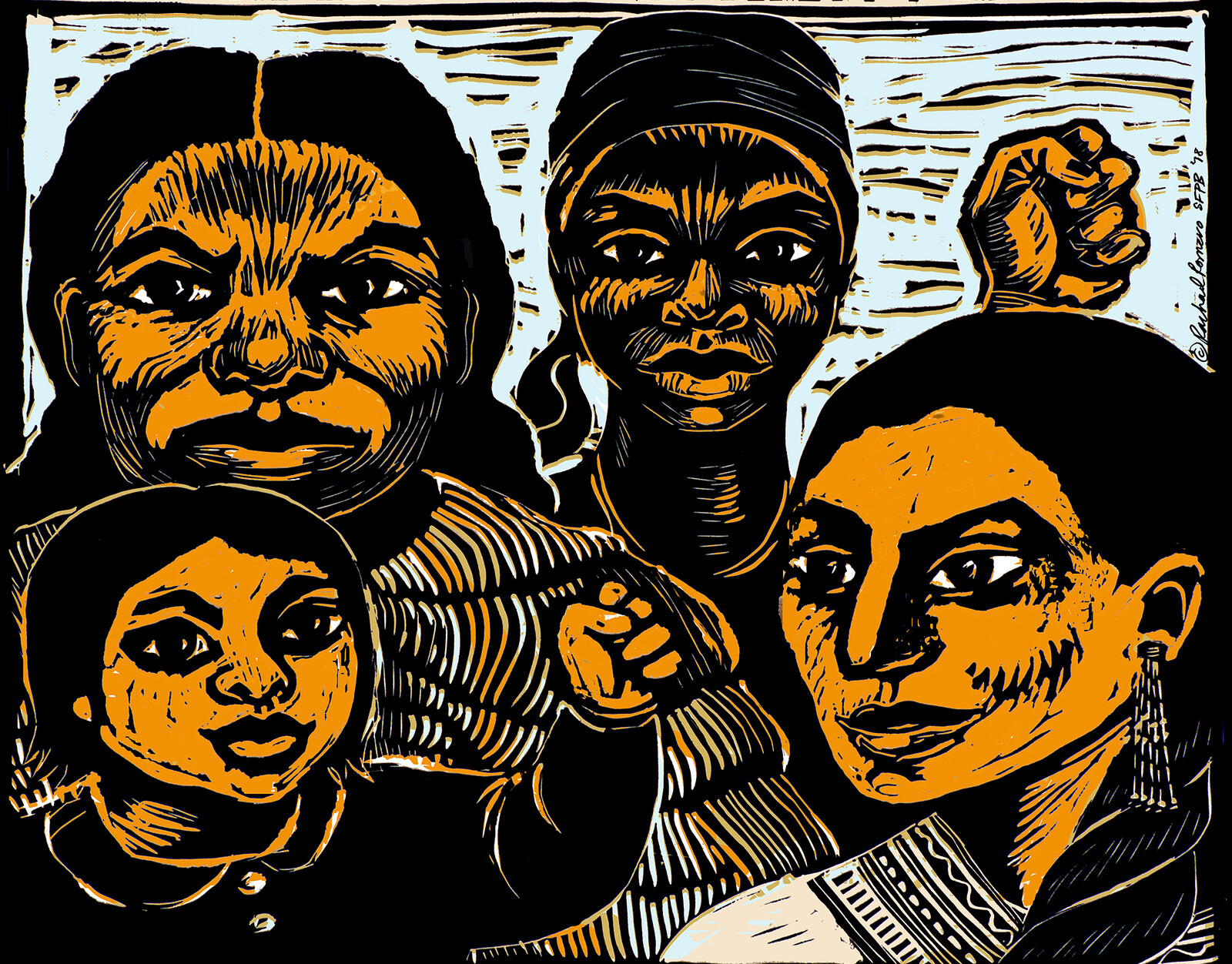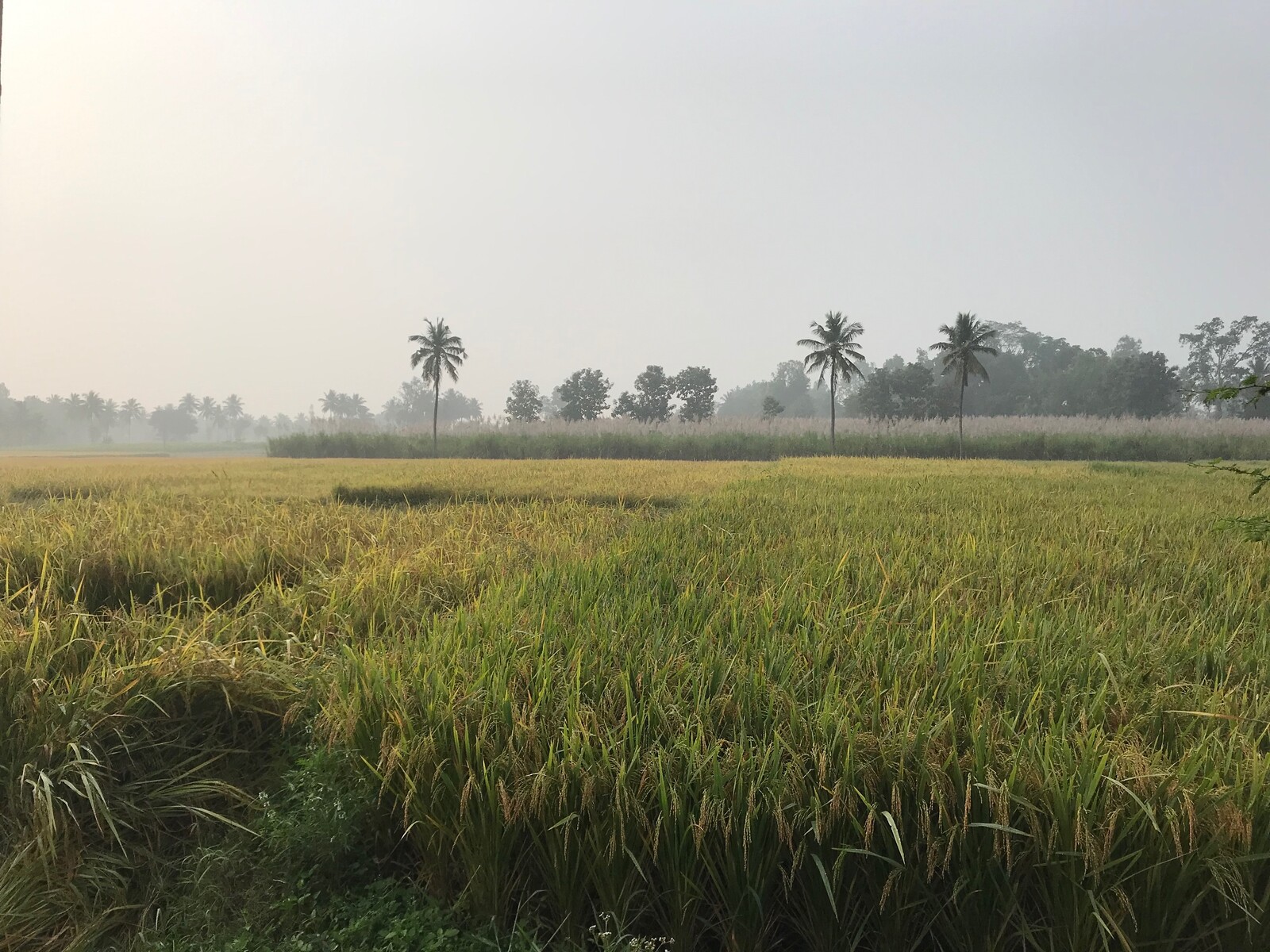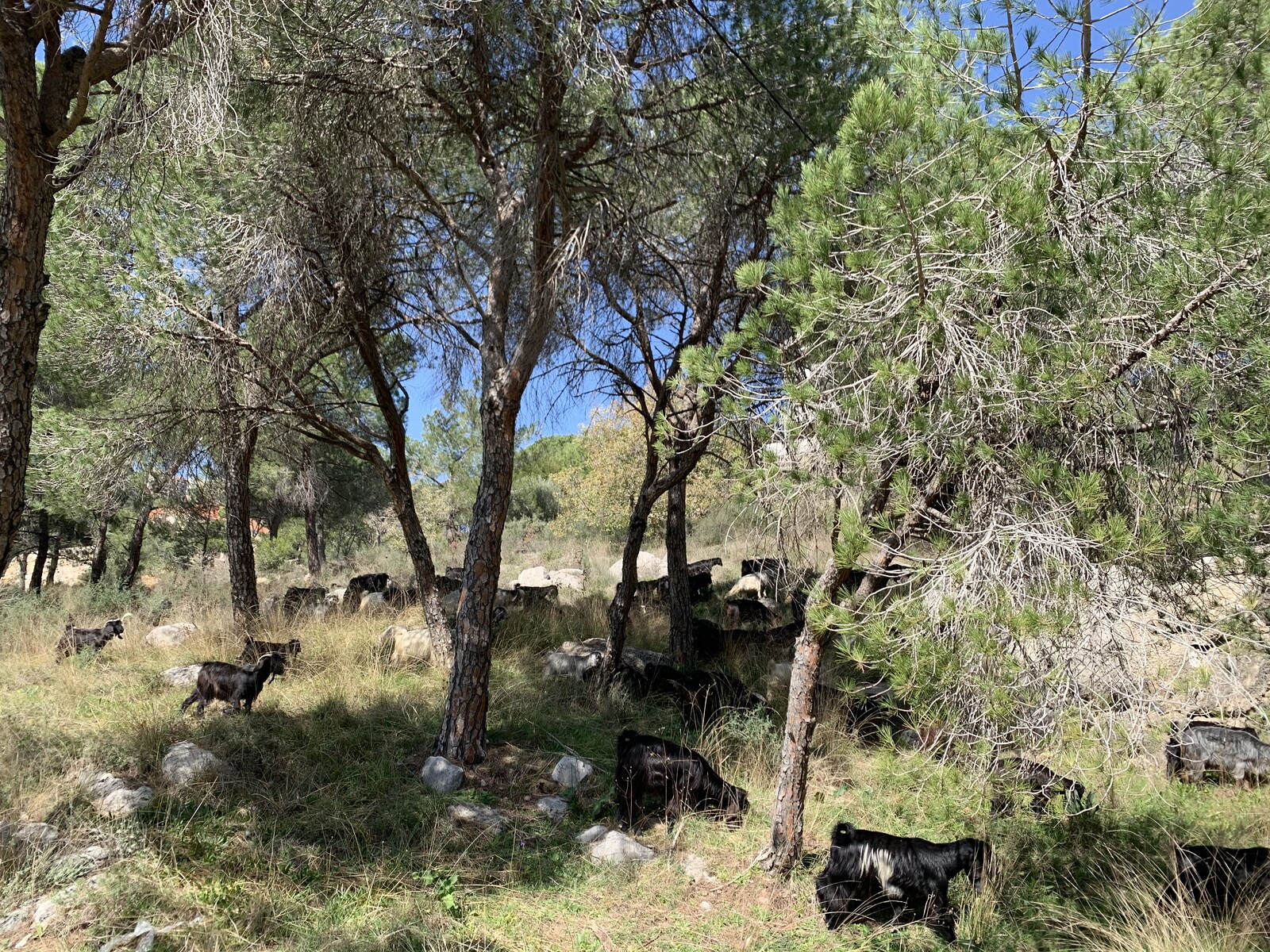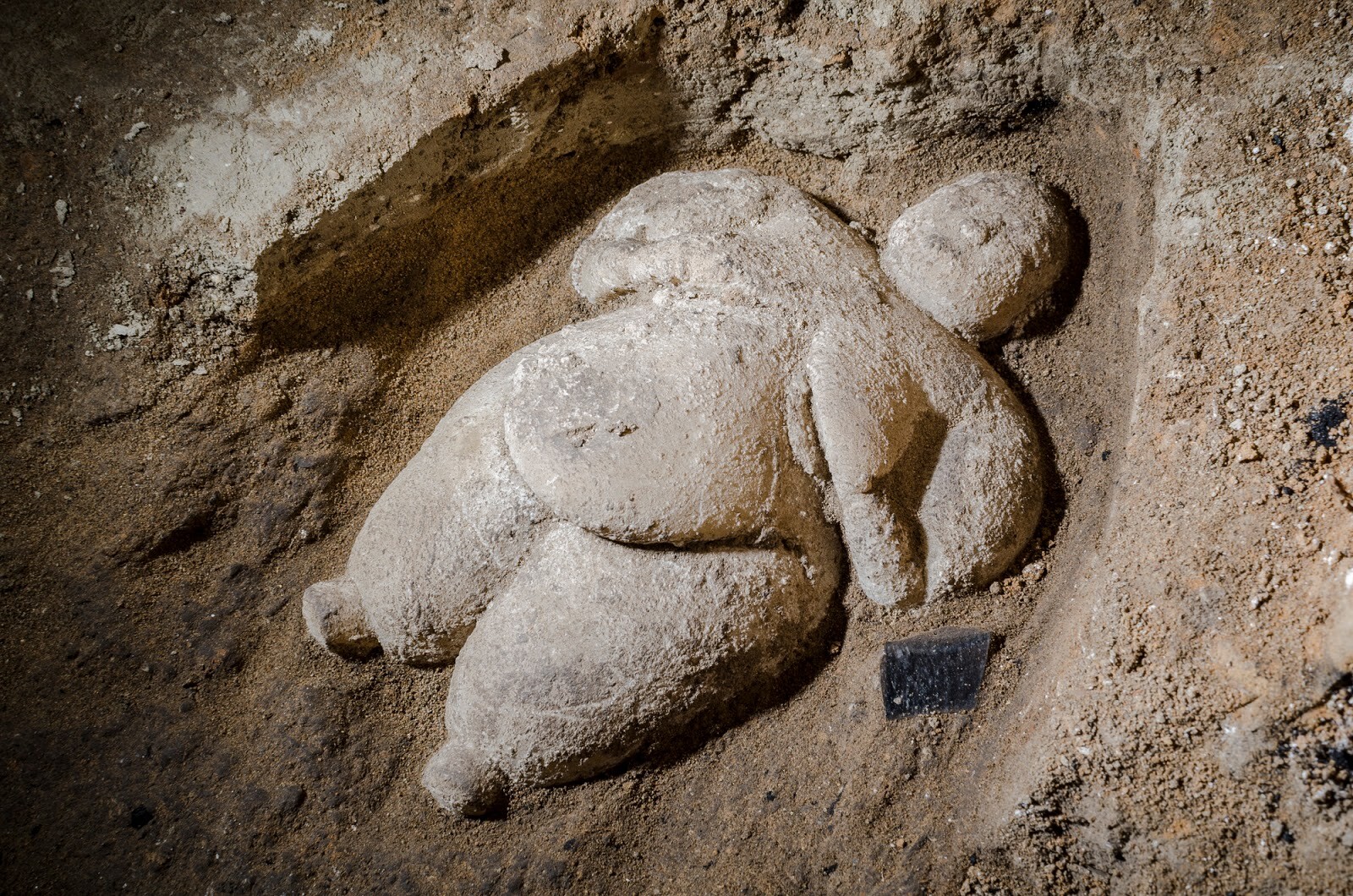For many Native American communities, understandings of family, fertility, and “collective continuance” are closely rooted to the protection, preservation, and revitalization of native seeds.1 Following on generations of eradication and assimilation, during which the fertility of both Native peoples and gardens have come under threat, Native people have utilized or developed a series of movements, including the reproductive justice movement, the environmental justice movement, and the seed rematriation movement, in an effort to protect and reunite Native families, including their seed relatives.
Sky Woman’s Daughters: The seeds she brings with her
In Mohawk culture, women’s reproductive capabilities are closely connected to those of the land and that which is planted on it.2 In the Mohawk creation story, Sky Woman fell through a hole in the sky caused by the uprooted celestial tree. She plummeted to the watery world below, her fall broken by a flock of geese that laid her on the back of a giant turtle. The muskrat brought up mud from below the water to make the surface softer for her, which Sky Woman then used to create the earth humans now rest on. Sky Woman gave birth to a daughter, who matured and became pregnant, but then died in the process of giving birth to twin boys. Sky Woman buried her, along with seeds that she had grabbed from the sky world on her descent, and from her body sprang corn, beans, and squash—the staples of the Mohawk diet. According to Mohawk midwife Katsi Cook:
They say corn is the breast milk of the Mother Earth, and it is very true. Complemented with the beans and squash they create the perfect protein…The very act of husking the corn, is like seeing a newborn baby. My, how beautiful it is! …In Mohawk, the word for bundling a newborn baby is “putting the husk back onto the corn,” so every one of these babies that comes to us is an ear of corn!3
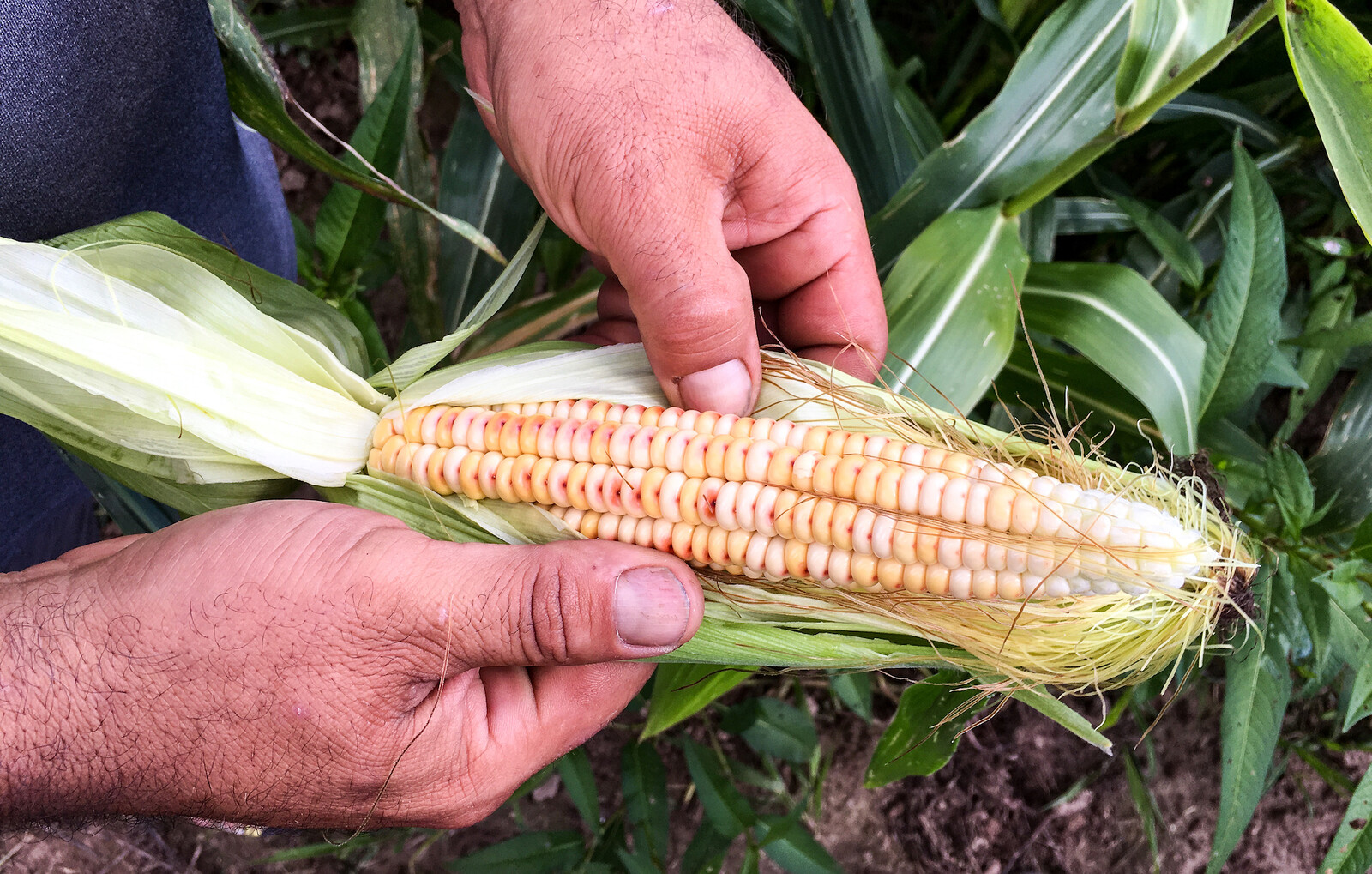
Akwesasne Mohawk farmer and cultural educator Kenny Perkins peels back the husk on an ear of Mohawk Red Bread corn still in the green stage. Photo by Elizabeth Hoover, August 2017.
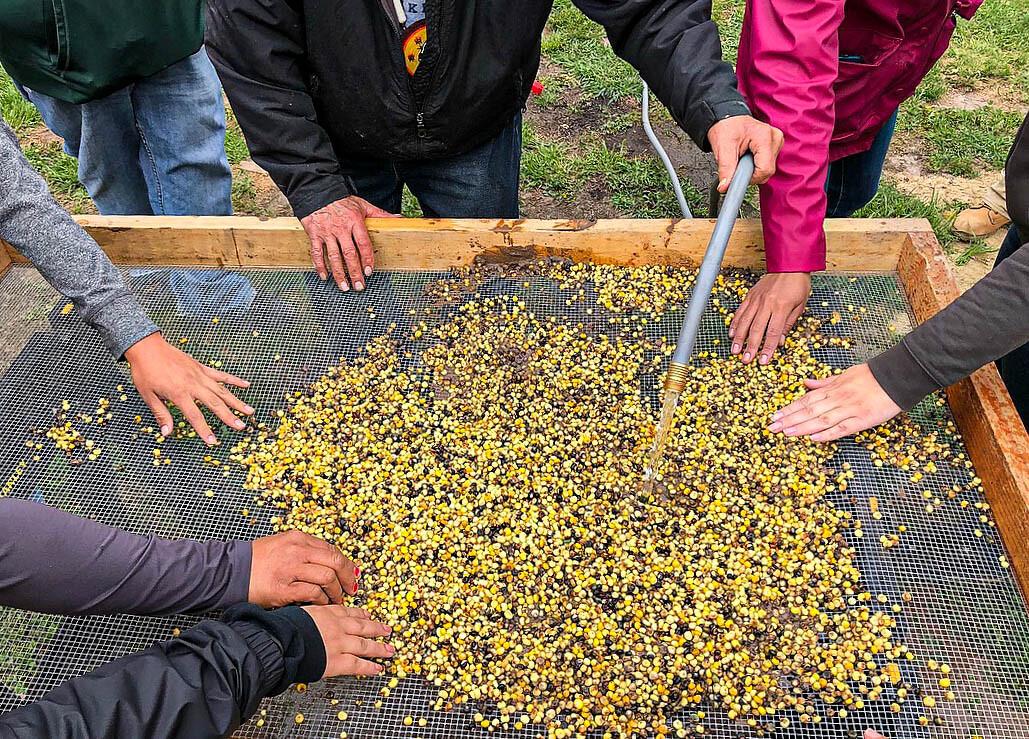
At a Great Lakes Food Summit hosted by the Meskwaki Nation, Potawatomi elder George Martin led a workshop teaching other Native people how to boil flint corn (in this case Red Lake flint corn) in hard wood ash to remove the outer hull for easier digestion, in order to make soup corn. Here they are rinsing the ash from the corn over a screen. Photo by Elizabeth Hoover, May 2018.

Glenda Abbott (Cree), an attendee at the Indigenous Farming Conference hosted by the White Earth Land Recovery Project in Minnesota, holding Bear Island Flint Corn that has been dried, hulled, boiled in hard wood ash, and dried again to become soup corn. Photo by Elizabeth Hoover, March 2017.
Akwesasne Mohawk farmer and cultural educator Kenny Perkins peels back the husk on an ear of Mohawk Red Bread corn still in the green stage. Photo by Elizabeth Hoover, August 2017.
Many other tribes across the US, from the Cherokees and Creeks in the southeast to the Mandan and Pawnees of the plains to the Zuni and Hopi in the southwest, have stories about the connection between important crops and women who sustain their communities. Buffalo Bird Woman, a Hidatsa seed keeper, described her nation’s relationship between plants and people as follows: “We care for our corn…as we would care for a child; for we Indian people loved our gardens, just as a mother loves her children.”4
In Akwesasne, a Mohawk community on the New York/Canadian border, the connection between women’s fertile bodies and these important cultural foods are reinforced through Mother Earth gardens, which were planted as part of the Ohero:kon Rites of Passage ceremonies revitalized by Bear Clan Mother Louise MacDonald and her family. As part of this ceremony, young men shape a pile of dirt into the form of a woman’s body, while the uncles lead them in a discussion about the sanctity of women. The young women then plant seeds on the woman-shaped garden—corn at her breasts, strawberries at her heart, beans at her fingers, squash at her navel, and sunchokes at her feet—just as they sprang up from the grave of Sky Woman’s daughter. The aunties guiding them speak about the importance of recognizing the fertility of their own developing bodies, and the importance of tending to these seeds and this garden like babies who cannot survive without proper care from their mother. The vitality of seed, land, and the culture of these young initiates are inextricably linked.
In addition to providing an origin story for some of the most culturally important foods, the Mohawk creation story has also been used as a metaphor for the development of the seeds carried inside young women. Beverly Cook is a nurse practitioner (now elected chief) who uses this story to explain fertility to Mohawk girls. One January afternoon in 2015, Bev stood in front of a group of girls in their second year of the Ohero:kon ceremony. As they sat on the wooden benches facing her, she described to them, “this is why women are the land—women made that land, women made that initial life that grew here on this earth. Her knowledge translated into every single woman descended from her.”5
Bev used the Mohawk creation story to explain the process of ovulation to young women, describing how the journey that the egg makes from the fallopian tube to the uterus is that same journey that Sky Woman made from the sky world carrying seeds. Each month the uterus develops a soft lining, similar to the way the muskrat brought mud to Sky Woman to create a soft layer on the turtle’s back. Bev described how, similar to the way that Sky Woman brought her seeds with her, when a woman is pregnant with a little girl, that female fetus carries all of her eggs with her, and hence each mother carries not only her daughter but her grandchildren as well. “That transmission of those seeds that Sky Woman brought here, every woman brings those here.” For this reason, she described to the girls the importance of taking care of their bodies, and creating a safe and protective environment for themselves and each other. The message was that women and seeds are sacred: women carry the seeds to both people the nation, and plant the fields to feed them.
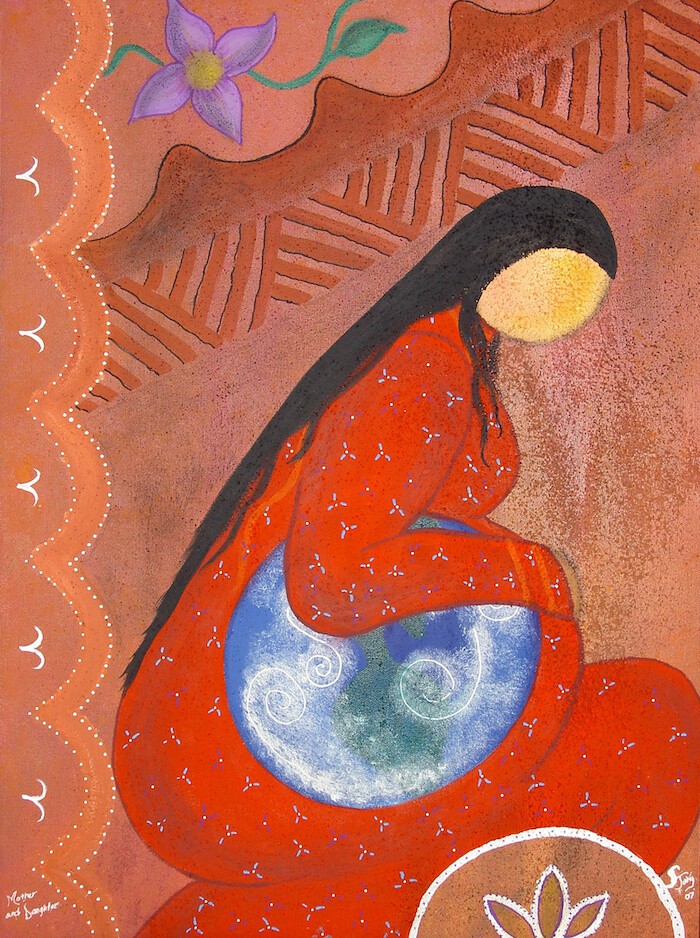

Mother and Daughter, a painting by Akwesasne Mohawk Artist Shirelle Jacobs (Tahy) featuring Sky Woman pregnant with the whole world. Shirelle is a mother, artist, and birth worker who seeks to empower Native women of all ages. For the author, this piece provides a visual for the words of Mohawk midwife Katsi Cook who emphasizes that “woman is the first environment” that everyone is exposed to as they make their way into this world. It is important to ensure that this environment does not become contaminated through environmental toxins.
Reproductive Justice and the Assault on Native Families
Native women’s bodies, seeds, land, and culture have been under assault for over four centuries. This destruction began with the first Euro-Americans driving Native people from their land and tearing it up with plows, and has continued with commercial farms reliant on chemical inputs into sterile soil in order to produce crops sowed from patented seeds that can’t be replanted. Many of these commercial seeds are distantly related to native seed varieties that were collected by Euro-American botanists and seed breeders from Indigenous growers in the late-nineteenth and early-twentieth centuries. Historian Christina Gish Hill describes how Oscar Will, his son George, and their seed company got its start with Mandan, Hidatsa, and Arikara seeds that they collected from surrounding Native communities. Hill notes that the seed catalogues simultaneously celebrate the contributions of Native farmers while constructing the acquisition of seed as gift or discovery, and ultimately portraying them as disappearing.6 Over the ensuing decades, these seeds were mined for their genetic material and hybridized and reshaped to fit the needs of settler farmers.
At the same time that seeds were being removed from their home communities for the purpose of re-breeding and re-packaging for the use of Euro-American farmers (working land taken by force from Native communities), Native American youth were also taken from their homes and sent to boarding schools to be re-educated and assimilated, and then farmed out as labor to white families. At these schools, Native students were encouraged to forget their tribal connections and foodways, as the staples of the standard diet there embodied Anglo ideals of foodways and nutrition, centering around starches and dairy for students previously used to diets centered around fresh and dried meats, fruits, and vegetables.7
For many First Nations children sent to residential schools, “the abiding condition was hunger,” as students were deprived of sufficient food, or given food of poor quality.8 Students returning from these schools arrived back to their communities with a very different relationship to food than when they had departed. In 1893, US legislation prohibited the removal of Native American children to off-reservation schools without the full consent of their parents, although for children who continued to be taken away, whether the consent of their parents was given willingly or not is questionable. Boarding schools continued to function throughout the twentieth century, but began to decline by the 1930s as many felt they had failed in their mission of complete assimilation.9
The assault against Native families and rights to cultural and physical reproduction continued from schools into clinics. Reports surfaced in the 1970s that Indian Health Service (IHS) clinics, which were tasked with providing health care for American Indian people, were sterilizing Native women without their informed consent as part of a campaign to reduce family size in populations seen as uncooperative and too reliant on the American government for services. It is suspected that at least one quarter of Native American women between the ages of 15 and 44 were sterilized by IHS during the 1970s.10
Surveys of the doctors performing these surgeries found that the majority were Euro-American males who believed they were helping society by limiting the number of births in low-income families of color. This would not only enable the government to cut funding for healthcare and welfare programs, but also increase their own personal income by performing hysterectomies and tubal ligations instead of prescribing alternative methods of birth control.11 While the option to have these procedures done should be made available to every woman, it is a decision that requires clear and conscious consent. In 1976, Congress passed the Indian Health Care Improvement Act, which gave tribes the right to manage or control Indian Health Service programs. Many tribes have taken over IHS facilities and have started their own health services, working to serve more culturally appropriate health care to their communities.12 These facilities, especially those in communities without many sources of steady income, are currently working against the challenges of underfunding and understaffing to provide safe healthcare.
For Native women who were able to give birth, the legacy of compulsory attendance of boarding schools was replaced with rampant adoption of Native children into non-Native families. Native children were removed from their families by state courts and welfare agencies at staggering rates—an average of one quarter of Native American children lived away from their parents during the early 1970s.13 By 1974, the Child Welfare League of America, Bureau of Indian Affairs (BIA), and state agencies had placed 25–35% of Native American children in foster and adoptive homes or institutions, including boarding schools.14
Many white adoptive parents saw adopting Native American children as an attractive option, as they imagined indigenous children as noble, close to nature, and “disappearing.”15 For these Native youth adopted into white families, life was challenging, as they grew up without their culture and tribal community, but still faced racism directed towards Native people. Tribal communities rallied to stem this flow of youth away from their tribal families, and in 1978 the Indian Child Welfare Act (ICWA) was passed, which worked to protect the interest of Native children, parents, and nations by giving greater tribal control over court proceedings for child removals, and dictating that Native kids who could not remain in their homes would be placed with their extended family, their tribe, and finally other Native Americans. Tribes also began developing their own social welfare systems to provide help for families and short-term foster care within the reservation community. 16
Out of this legacy of threats to families of color, the Reproductive Justice (RJ) movement arose as women fought to protect their rights to family. Organizations like WARN (Women of All Red Nations) were formed in the 1960s to defend the rights of Native women. The RJ movement built on this work, as well as that by other grassroots women of color organizations, to develop a national multi-ethnic scope in the 1990s. SisterSong, a women-of-color-centered organization focused on reproductive justice, was founded in 1997 in an effort to address issues that they felt had been left out of the white feminist agenda. As founding member Loretta Ross describes:
For Indigenous women and women of color it is important to fight equally for (1) the right to have a child; (2) the right not to have a child; and (3) the right to parent the children we have, as well as to control our birthing options, such as midwifery. We also fight for the necessary enabling conditions to realize these rights. This is in contrast to the singular focus on abortion by the prochoice movement that excludes other social justice movements. The Reproductive Justice framework analyzes how the ability of any woman to determine her own reproductive destiny is linked directly to the conditions in her community—and these conditions are not just a matter of individual choice and access. Reproductive Justice addresses the social reality of inequality, specifically, the inequality of opportunities that we have to control our reproductive destiny.17
Environmental Reproductive Justice and Seed Sovereignty
For many Native communities, the fight for reproductive justice was not only against government agencies which would rob women of their reproductive capabilities or their children, but also against environmental conditions perpetuated by environmental policies that privileged industrial capitalism over the rights of those living on the land. Mohawk midwife Katsi Cook, who coined the term Environmental Reproductive Justice (ERJ), has spent most of her life fighting both for culturally relevant tribal birthing centers and against environmental contamination that would: a) impact the ability of families to conceive, birth, and raise healthy children; b) contaminate women’s breast milk; c) affect a Native community’s ability to reproduce culturally when access to a healthy environment is interrupted.18 In describing her work, Katsi states: “I see that reproductive justice and environmental justice intersect at the nexus of woman’s blood and voice. Environmental justice and reproductive justice intersect at the very center of woman’s role in the processes and patterns of continuous creation.”19
In examining the World Health Organization’s definition of health as a “state of complete physical, mental, and social well-being, not merely the absence of disease or infirmity,” as well as the ability to lead a “socially and economically productive life,” Katsi describes that she would “add cultural well-being to this definition, since ecologists have pointed out that biological diversity and cultural diversity go hand in hand.”20 She notes that in her community of Akwesasne, the struggles for environmental justice and reproductive justice coevolved, and included understanding the impact of environmental contaminants on women’s health as well as language and culture issues.21
The concept of environmental reproductive justice involves expanding the frameworks of environmental justice and reproductive justice to more closely consider the impact of the environment in contributing to or limiting reproduction. ERJ also seeks to expand what we think of as “reproduction” to include the ability to pass on culture and language as well as the reproduction of human beings.
Traditional foodways are an important means of supporting health and reproducing culture. The Indigenous food sovereignty movement seeks to ensure access to culturally relevant foods produced by ecologically and socially just methods that are linked to cultural restoration. Within that movement, for communities who have been reliant on horticulture for eons, a seed sovereignty movement has emerged, working to protect seeds—those other-than-human family members which have been developed by generations of seed keepers and gardeners and passed down—and bring them home if they are being stored away, as well as ensure that community members once again have access to them.
In interviews I conducted with Native American community-based farming and gardening projects across the United States, farmers and seed keepers described the importance of remaining connected, or reconnecting with previous generations of Native farmers in their families and communities through working with indigenous heirloom seeds.22 Holding a handful of beans, or a cob of corn, meant holding the results—the offspring—of many generations of decisions made by seed keepers; choices made at the end of each season to select seed based on preferred taste, color, size, and how well those plants performed that season. Becoming part of that cycle by planting, growing, harvesting, eating, and saving their own generations of these seeds means reconnecting or staying connected with these relatives—human and other-than-human.


Clayton Brascoupe (on the right) is a Mohawk seedkeeper who has lived for the past 40 years in his wife’s community of Tesuque Pueblo, where he farms with his family. He founded the Traditional Native American Farmers Association (TNAFA) which works to help Indigenous farmers across the US and Canada as well as Belize connect to traditional farming practices and plant heritage seeds. This photo was taken right after he gave a seed saving workshop at the Great Lakes Food Summit, hosted on the land of the Gun Lake Potawatomi in Michigan. Photo by Elizabeth Hoover, April 2017.
Of major concern to these communities is how to protect what they saw as both living relatives and community intellectual property from being tampered with or patented by multinational corporations. Clayton Brascoupe (Mohawk) has not only been working with heritage seeds, but also promotes ideas of seed sovereignty across Indian country. Brascoupe relocated to his wife’s community of Tesuque Pueblo four decades ago, and has coordinated the Traditional Native American Farmers Association (TNAFA) for over twenty years. As we sat at his kitchen table, surrounded by ears of blue corn and piles of beans from his gardens, I asked him to define what seed sovereignty meant to him:
We refer to these as our living relatives. So, we have to have control and the ability to protect our living relatives. That’s what seed sovereignty means to me. So that they can’t be molested, contaminated, or imprisoned. When I say imprisoned, I mean perhaps someone will say “this is some interesting stuff,” and they grow it up for a few years and all of the sudden they say they own it. If we can’t protect of our living relative, then somebody else may say they own it. They’re imprisoned and you can’t go visit and plant your relative. Also, if you have the ability to interact with your relatives through these seeds, you also have the ability to feed yourself well.23
Native people suffer some of the highest rates of imprisonment of any ethnic group in the US, and many boarding school survivors are working through the trauma of having been physically and sexually abused. Clayton’s description of the ways in which heirloom seeds as fellow relatives need to be protected from molestation and imprisonment extends this ongoing history of abuse of Native bodies and culture to objects which others might see as inanimate. To this end, the TNAFA and other organizations have drafted a Declaration of Seed Sovereignty and worked with local legislators to draft a bill that would help protect Native seeds—much in the way the previously described legislations worked to protect Native women, children, and families.
For seeds that have been taken away from the community, a seed rematriation movement has been developing to bring these seeds back to their home communities, to be planted again in the gardens of Native people. While many people are familiar with the term repatriation to refer to the linear one-way return of prisoners of war to their home county, or the return of ancestral remains and sacred objects to their countries of origin, the term rematriation was developed to honor women seed keepers, and also to refer to a more circular inter-connected process—reconnecting Indigenous people to their seeds, re-connecting seeds to the mother land on which they were developed, and in turn connecting people and the land.
A leader in this movement is Mohawk seed keeper Rowen White, who heads the Indigenous Seedkeepers Network (ISKN). In her words:
The word reflects the restoration of the feminine seeds back into the communities of origin. The Indigenous concept of Rematriation refers to reclaiming of ancestral remains, spirituality, culture, knowledge, and resources, instead of the more Patriarchally associated Repatriation. It simply means back to Mother Earth, a return to our origins, to life and co-creation, rather than Patriarchal destruction and colonization, a reclamation of germination, of the lifegiving force of the Divine Female.24
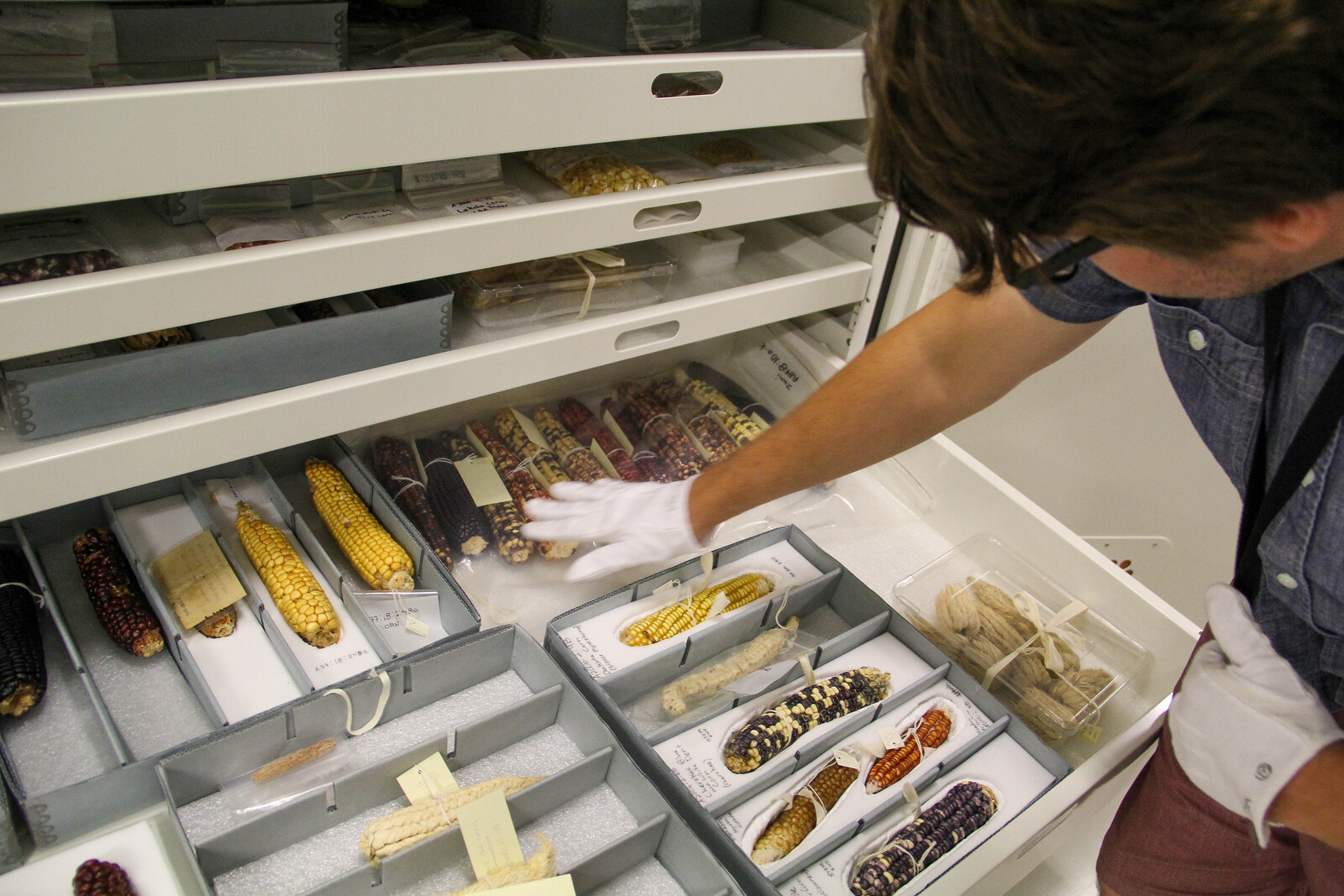
Scott Shoemaker, from the Miami tribe, worked as a curator at the Science Museum of Minnesota to grow out Native American heirloom seed varieties and return them to the communities from which they were collected. Photo by Elizabeth Hoover, August 2014.

The seeds from the Science Museum of Minnesota’s collection were sprouted and grown out in a little garden on the museum’s grounds. A few of the fresh new seeds were returned to the collection, and the rest were sent to Indigenous seed keepers and gardening projects. Photo by Eliabeth Hoover, August 2014.
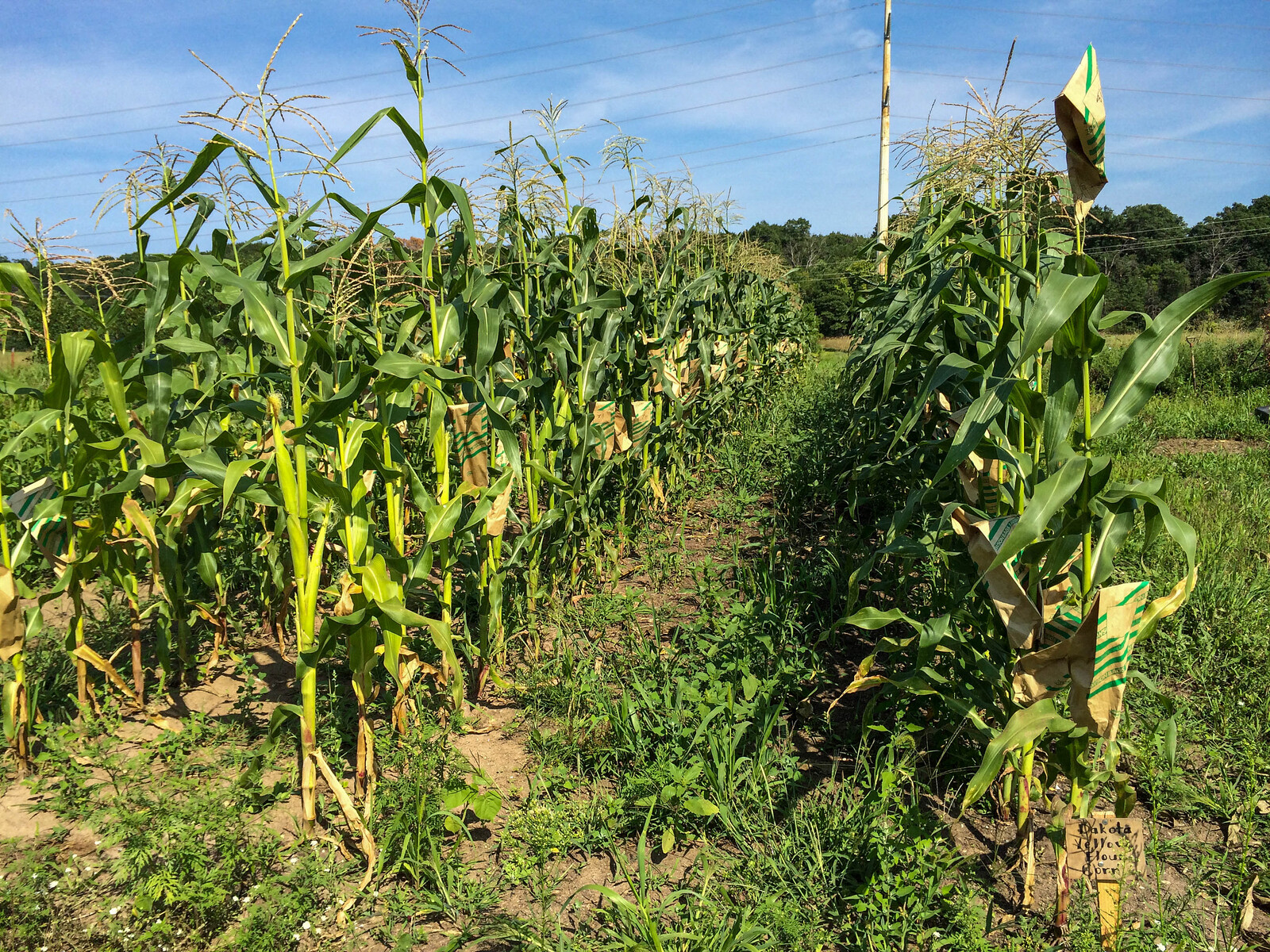
Dakota Yellow Flour Corn, a rare heritage variety of corn that came to Dream of Wild Health after it was sprouted from the collections of the Science Museum of Minnesota. The bags over the corn cobs are to ensure that other farmers’ GMO corn pollen did not drift into the field and cross-pollinate this corn. With a twinkle in his eye, Ernie Whiteman, an Arapaho elder who worked in the fields with the youth, pointed to this field and said, “If you notice, it’s been hooded. Corn condoms. We had instruction yesterday from a group of young people from the AIDS task force and they talked about safe sex. And in the morning we gave them a lesson on this so they had a safe sex for vegetables, safe sex for humans in the afternoon.” Photo by Elizabeth Hoover, August 2014.
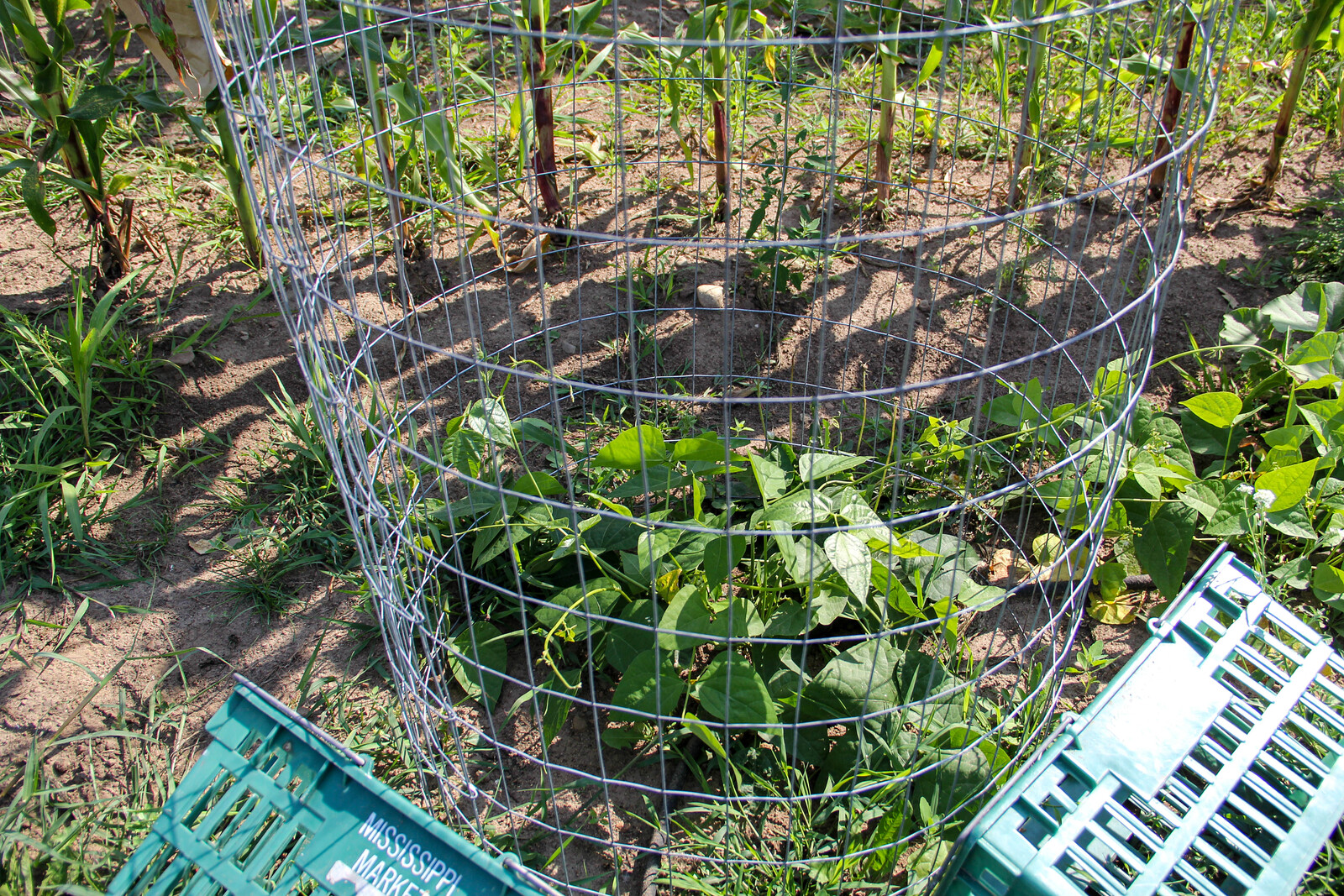
A rare Lakota bean from the Science Museum of Minnesota collection. They had ten 80-year-old seeds, ten 60-year-old seeds, and ten 40-year-old seeds. Only two of the seeds from the 40-year-old lot germinated, forming these plants, which were then carefully tended to produce viable seeds to replenish the collection. Photo by Elizabeth Hoover, August 2014.
Scott Shoemaker, from the Miami tribe, worked as a curator at the Science Museum of Minnesota to grow out Native American heirloom seed varieties and return them to the communities from which they were collected. Photo by Elizabeth Hoover, August 2014.
In the past decade, a movement led by ISKN, Native museum curators, and other allied organization members has grown to rematriate seeds held in institutions like museums, universities, and seed banks. For example, the Minnesota Science Museum, which houses an assortment of Native seeds collected by anthropologist/dentist Wesley Hiller during the 1930s and 1940s, began deaccessioning seeds from the collection to grow out in educational gardens, and then, beginning in 2009, give these newly grown seeds back to the communities from which they originated. Also under the guidance of Rowen and the ISKN, the Seed Savers Exchange—the largest public access seedbank in the country—began growing out and rematriating Native American seed varieties back to their home communities in 2018, beginning with a big beautiful green squash returned to the Taos Pueblo community as part of the Southwest Food Sovereignty Summit. As Rowen delivered the squash, which had been gone from the community for at least seventy years, Pueblo leadership and the women who run the tribal farm project welcomed the squash home like a returning relative, crying and cradling it like a baby between them. Another example is the Field Museum, which recently sent beans collected by Native anthropologist William Jones in 1909 back to the Meskwaki community from which they originated, in the hopes that they might sprout and return to Meskwaki gardens. And the University of Michigan Mattaei Botanical gardens is currently working with Michigan Anishinaabek Cultural Preservation & Repatriation Alliance (MACPRA) and the Ziibiwing Cultural Center to return seeds from the University museum’s collections back to Native people.
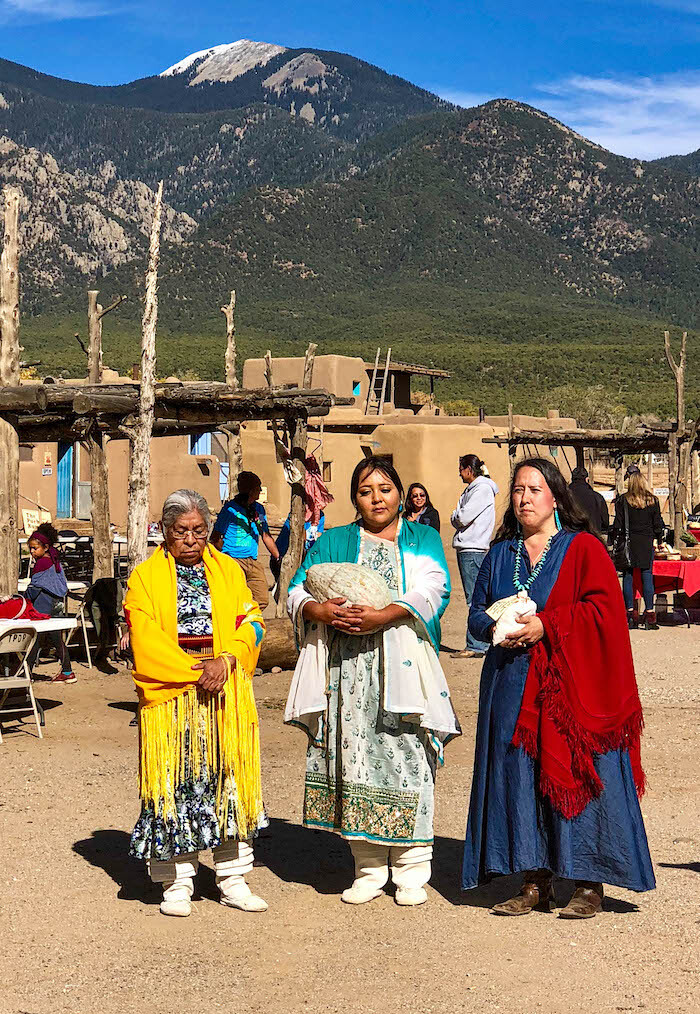

Tiana Suazo of Taos Pueblo cradling a squash that had been gone from the community for many years, but whose seeds were found in the Seed Savers Exchange collections, where Rowen White (red shawl) serves as chair of the board and has endeavored to return as many of the seeds originating from Native community back to their original homes. Henrietta Gomez, in the yellow shawl, is a respected seed keeper in the Taos Pueblo community. Photo by Elizabeth Hoover, October 2018.
Much in the way that communities sought out ancestors and sacred objects to be returned home from museums, and families are working to reconnect with children adopted out away from them, seed keepers are seeking out relocated seeds to bring home. The goal is “re-membering” the seeds, as Rowen calls it; bringing seeds back into their roles as family members, in addition to remembering or relearning how to plant, harvest, and cook them. She notes: “The seeds are a reflection of the people. When the seeds are weak and struggling, it means our communities and nations and people are struggling. And when our seeds are strong, it means our nations and communities and people are strong and in good health.”25 Through the efforts of individual farmers and seed keepers, as well as organizations like the Indigenous Seed Keepers Network and Traditional Native American Farmers Association, strength and health is supported and returning to tribal nations and peoples.
According to Kyle Whyte, collective continuance is “a community’s capacity to be adaptive in ways sufficient for the livelihoods of its members to flourish into the future…The flourishing of livelihoods refers to both tribal conceptions of (1) how to contest colonial hardships, like cultural discrimination and disrespect for treaty rights, and (2) how to pursue comprehensive aims at robust living, like building cohesive societies, vibrant cultures, strong subsistence and commercial economies, and peaceful relations with a range of non-tribal neighbors.” Kyle Powys Whyte, “Justice Forward: Tribes, Climate Adaptation and Responsibility,” Climatic Change 120, no. 3 (2013): 517–530, 518.
The Mohawk Nation is part of the Haudenosaunee Confederacy, whose traditional territory stretches across what is now known as New York State.
Tsí Yotsihstokwáthe Dakota Brant, “Onhehste’ón:we: ‘The Original Corn,’” posting on Indigenous Food Sovereignty Network’s Facebook page, March 1, 2009. Quoted in Elizabeth Hoover, The River is in Us: Fighting Toxics in a Mohawk Community (Minneapolis: University of Minnesota Press, 2017), 212.
Quoted in Christina Gish Hill, “Seeds as Ancestors, Seeds as Archives: Seed Sovereignty and the Politics of Repatriation to Native Peoples,” American Indian Culture and Research Journal 41, no. 3 (2017): 93–112.
Beverly Cook presenting to Ohero:kon second years, January 2015. Author was in attendance as an auntie to one of the young women.
Hill, “Seeds as Ancestors.”
Jennifer Bess, “More Than a Food Fight: Intellectual Traditions and Cultural Continuity in Cholocco’s Indian School Journal 1902–1918,” American Indian Quarterly 37, no. 1–2 (2013): 77–110.
Ian Mosby and Tracey Galloway, “‘The abiding condition was hunger’: Assessing the long-term biological and health effects of malnutrition and hunger in Canada’s residential schools,” British Journal of Canadian Studies 30, no. 2 (2017): 147–162.
See: Meg Devlin O’Sullivan, “‘More Destruction to These Family Ties’: Native American Women, Child Welfare, and the Solution of Sovereignty,” Journal of Family History 41, no. 1 (2016): 19–38; David Wallace Adams, Education for Extinction: American Indians and the Boarding School Experience, 1875–1928 (Lawrence: University Press of Kansas, 1995).
Jane Lawrence, “The Indian Health Service and the Sterilization of Native American Women,” American Indian Quarterly 24, no. 3 (2000): 400–419.
Ibid.
Ibid., 414–415.
O’Sullivan, “‘More Destruction to These Family Ties.’”
Ibid., 22.
Ibid., 24, quoting David Fanshel, Far from the Reservation: The Transracial Adoption of American Indian Children, a Study Conducted under the Auspices of the Child Welfare League of America, New York, New York (Metuchen: The Scarecrow Press, 1972), 89–93.
O’Sullivan, “‘More Destruction to These Family Ties.’”
Loretta Ross, “What Is Reproductive Justice?” in Reproductive Justice Briefing Book: A Primer on Reproductive Justice and Social Change (SisterSong Women of Color Reproductive Justice Collective and Pro-Choice Public Education Project, 2007), 4, ➝.
Elizabeth Hoover, Katsi Cook, Ron Plain, Kathy Sanchez, Vi Waghiyi, Pamela Miller, Renee Dufault, Caitlin Sislin, and David O. Carpenter, “Indigenous Peoples of North America: Environmental Exposures and Reproductive Justice,” Environmental Health Perspectives 120, no. 12 (2012): 1645–1649, ➝.
Katsi Cook, “Environmental Justice: Woman Is the First Environment,” in Reproductive Justice Briefing Book: A Primer on Reproductive Justice and Social Change (SisterSong Women of Color Reproductive Justice Collective and Pro-Choice Public Education Project, 2007), 62–63, ➝.
Ibid.
Ibid.
See: Elizabeth Hoover, “‘You can’t say you’re sovereign if you can’t feed yourself’: Defining and Enacting Food Sovereignty in American Indian Community Gardening,” American Indian Culture and Research Journal 41, no. 3 (2017): 31–70; Elizabeth Hoover and Sean Sherman, “‘The answers to our ancestors’ prayers’: Seeding a movement for health and culture,” 2018 Oxford Symposium on Food & Cookery, St Catherine’s College, Oxford, July 6–8, 2018. Paper and presentation won the “Oxford Food Symposium Outstanding New Presenter Award.”
Author’s interview with Clayton Brascoupe, Tesuque Pueblo, New Mexico, June 11, 2014.
Rowen White, “Seed Rematriation,” Sierra Seeds, March 19, 2018, ➝; Rowen White, “One Happy Homecoming,” Seed Savers, December 20, 2018, ➝. See also Rowen White and Elizabeth Hoover, “Our Living Relatives: Maintaining Resilience and Seed Diversity in Native American Communities,” The New Farmer’s Almanac, Volume IV: The Greater “We,” ed. The Greenhorns (Sonoma: McNaughton & Gunn, 2019).
White, “Seed Rematriation.”
Exhausted is a collaboration between SALT and e-flux Architecture, supported by L’internationale and the Prince Claus Fund.
Category
Subject
This essay is based on chapter 2 of the author’s forthcoming book, From Garden Warriors to Good Seeds: Indigenizing the Local Food Movement (University of Minnesota Press) and Elizabeth Hoover, “Environmental Reproductive Justice: Intersections in an American Indian Community Impacted by Environmental Contamination,” Environmental Sociology 4, no. 1 (2018): 8–21.
Exhausted is a collaboration between SALT and e-flux Architecture, supported by L’internationale and the Prince Claus Fund.
